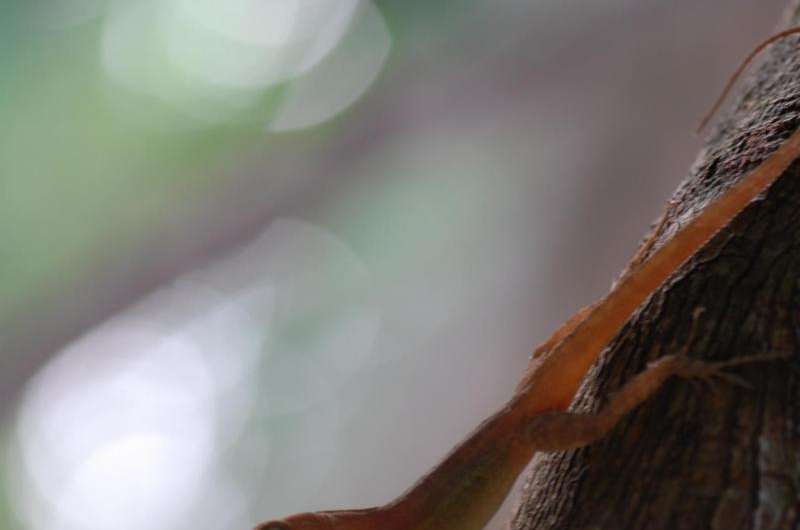Look at me! Forest-dwelling anoles 'glow' to attract attention

See and be seen. In the elaborate game of seeking and attracting a mate, male anole lizards have a special trick—they grab attention by perching on a tree limb, bobbing their heads up and down, and extending a colorful throat fan, called a dewlap.
Among anoles living in shaded habitats, the dewlap is often translucent. It passes as much or more light through it from the back, as it reflects from the front. The dramatic "glowing" effect, according to a new study published in Functional Ecology, increases the efficacy of the male lizard's visual signal, making them stand out better to females.
"When I first saw this glowing effect in the field, I thought, 'Wow! There is something special about this,'" said Manuel Leal, a biologist at the University of Missouri who coauthored the study.
For lizards, shady habitats can be "visually noisy" environments, with branches and leaves waving in the breeze. How can a bachelor lizard stand out? Leal and his colleagues hypothesized that this glowing effect makes the lizard's visual signal easier to detect by either making the dewlap appear brighter or making the colors more conspicuous against this background.
"When lizards are displaying amongst trees, where the background is shaded, a feature like this actually makes a lot of sense," said Leal.
To test their hypothesis, Leal and his colleagues studied Jamaican Gray lizards, Anolis lineatopus, which live in shaded forests throughout the island. They recorded the natural light conditions at locations where the lizards were observed perching and/or displaying. They also measured both the reflective and translucent properties of A. lineatopus as well as of three other anole lizards that occupy the same habitat.
The researchers plugged all the data into a complex color space model of the anole's visual system to calculate the colors of the lizard's throat fan with and without the effects of the transmission. The method allowed the researchers to understand how the colors of the lizard's throat fan look from the eyes of another anole.
Leal and his colleagues found that the perceptual overlap between the colors of the lizard's throat fan and the natural colors of the background decreased when light is transmitted through the dewlap.
"Allowing light to pass through the dewlap makes the colors of the dewlap much easier to detect and to distinguish against other objects in the background, which means the signal is easier to see by potential mates and rivals," explained Leal. "In other words, it increased the signal-to-noise ratio."
Translucent coloration is found throughout the animal kingdom, most especially in marine animals and insects. Its purpose and underlying mechanism, however, is not well understood. According to the authors, "this is the first study to demonstrate the evolutionary advantage of possessing a translucent display organ that uses diffuse transmitted light to increase its visibility."
There are more than 400 species of Anolis in the Caribbean and Americas, making them of particular interest to scientists studying the evolution of signals.
The study, titled "Why do Anolis dewlaps glow? An analysis of a translucent visual signal," appears in 28 July issue of Functional Ecology.
More information: Functional Ecology, onlinelibrary.wiley.com/doi/10 … -2435.12502/abstract
Journal information: Functional Ecology
Provided by University of Missouri-Columbia





















